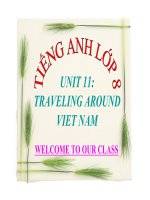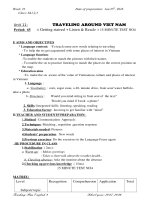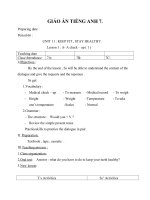Giáo án Tiếng Anh 8 unit 11: Traveling around Vietnam
Bạn đang xem bản rút gọn của tài liệu. Xem và tải ngay bản đầy đủ của tài liệu tại đây (116.47 KB, 6 trang )
GIÁO ÁN TIẾNG ANH LỚP 8.
Unit 11: Traveling around VIET NAM
Lesson 4/67: Read
A. Aim:
By the end of the lesson, students will be able to read for details to understand the
content of the text about some places of interest in Vietnam.
*. Lexical item : Limestone , accommodation , tribe , waterfall , giant ,
magnificent.
*. Skill : Reading.
*. Techniques : Practice in pairs.
*. Teaching aids: posters, pictures.
B. Procedures:
I. Warm-up:
Chatting
- Ask ss to some questions:
? Where is Ha Long Bay?
? Are there flights to Sa Pa?
II. Pre-reading:
1. Vocabulary:
- limestone
(n) :
đá vôi
(visuals)
- accommodation
(n) :
chỗ ở
(translation)
- tribe
(n) :
bộ tộc, bộ lạc
(explanation)
- waterfall
(n) :
thác nước
- giant
(adj :
- magnificent
(adj) :
to lớn, khổng lồ
lộng lẫy, đầy ấn tượng
(visuals)
(visuals)
(example)
* Checking vocabulary: Slap the board.
2. Quiz: What's this place?
- Hang on the poster and pictures on board and ask ss to look at them.
- Ask them to guess which statements belong to each place: Nha Trang, Da Lat, Sa
Pa, Ha Long Bay.
Places
Statements
Nha Trang
Da Lat
Sa Pa
Ha Long
Bay
III. While-reading:
1. Checking ss' guessing:
- Ask ss to open their book on p.102 - 103 and read the text to check.
- Ask them go to the board and correct.
* Answer key:
Nha Trang: 2, 6
Da Lat: 1, 3, 9
Sa Pa: 4, 7, 10
Long Bay: 5, 8
2. Grids: ( p.104)
- Let ss read the text again then check () the topics mentioned in the grids on
p.104.
- Get ss to work inpairs to compare their answers.
* Answer key:
- Nha Trang: flights to Hanoi, railway, hotels, local transport, tourist attractions.
- Da Lat: hotels, local transport, waterfalls, tourist attractions.
- Sa Pa: hotels, local transport, mountain slopes, tourist attractions, villages.
- Ha Long Bay: World Heritage, tourist attractions, sands beaches, railway, hotels,
caves, local transport.
IV. Post-reading: Interview
Tourist
Would you mind if I asked you a question?
Tourist officer
No, I don’t mind.
I studies tribes around the world. I like
mountain-climbing. Do you mind suggesting
You should go to visit
one?
Sapa.
Thank you.
You are welcome
- Ask ss to look at book on p.105.
- Imagine you are a foreign tourist who wants to spend your coming summer
vacation in Vietnam. Ask Tourist officer where should you go.
- Devide class into 4 groups:
Group 1: Mary
Group 2: John
Group 3: Joanne
Group 4: Donna
V. Homework:
- Learn by heart vocabulary.
- Do exercises in workbook.
- Prepare for Write.
Unit 11: Traveling around VIET NAM
Lesson 5/68: Write
A. Aim: By the end of the lesson, students will be able to know how to
write a narrative.
*. Grammar : Write a narrative .
*. Skill : Wrting.
*. Techniques : Practice in pairs and group.
*. Teaching aids: posters, pictures.
B. Procedures:
I. Warm-up:
Gap filling
Which words?
- Get ss to study the definition of a narrative by a gap fill.
written climax attention brief events
- Show the chart and ask ss to fill in the gaps with the words in the box.
A narrative is a sequence of ---(1)---. These events are usually ---(2)--- in
chronological order and often lead to a ----(3)----. The first sentence of a narrative
should get the reader’s ----(4)---- and the ending should be -(5)---.
- Explain the definition in Vietnamese.
(1) events (2) written
(3) climax
(4) attention
(5) brief
II. Pre-writing:
* Odering statements:
- Ask ss to open their books, read the first part of the story on p.105 and rearrange
the sentences on p.106 to complete a story.
- Ask ss tocompare with friend then give their answers.
- Ask them read out the story.
III. While-writing:
1. Odering pictures:
- Ask ss to look at the pictures on p.106-107 then order the pictures.
* Key:
c-a-g-d-f-b-e
2. Dictation:
- Dictate the first sentence of the story to ss: “she had a math exam on Friday and
she up late”.
- Call one student to the board to write the sentence.
- Let other ss correct it until it is right.
- Ask them to underline all verbs, check if they are in simple past tense.
- Explain what tense we need to use (simple past ) and why.
* Odering pictures: d - b - e - h - a - f c - g
* Word cue drill (answers):
a/ Suddenly, she stumbled against a rock and fell.
b/ She realized her alarm clock did not go off.
c/ Strangely, the rain stopped as she got to her classroom.
d/ She had a math exam on Friday and she got up late.
e/ As she was leaving home, it started to rain heavily.
f/ Her school bag fell in a pool and everything got wet.
g/Luckily, Uyen had enough time to finish her exam.
h/ Uyen tried to run as fast as she could.
- Ask ss tolook at word cues then write full sentences.
- Work individually.
- Ask them to share with their friends
IV. Post-writing:
- Call ss go to the board to write the sentences.
- Let ss look at all the sentences to find mistakes and correct.
- Ask ss toread aloud the sentences.
- Give feedback and correct.
- Ask ss tonotice the simple past tense is often used in a narrative.
V. Homework:
- Do exercises in workbook.
- Prepare for revision.









